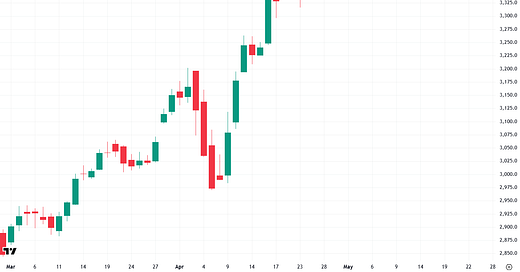Today brought a sigh of relief across financial markets as risk assets—stocks and cryptocurrencies—rebounded sharply from oversold levels. The official catalyst was President Donald Trump’s move to de-escalate tensions with Federal Reserve Chair Jerome Powell, reassuring investors that he has no plans to fire him. Following those remarks, major U.S. stock indices rallied roughly 2.5%.
Gold, which had been climbing amid the political tension, gave back its earlier gains—after briefly spiking to $3,500 in COMEX futures, it settled at $3,419.40. In today’s update, I’m going to explore whether this abrupt reversal in gold could mark the peak of its powerful multi-month rally—and what it would mean if that’s indeed the case.
During the Tuesday Asian trading session, COMEX gold futures once again surged—a pattern we've seen frequently in recent weeks. This time, however, the rally briefly breached the key $3,500 resistance level before retreating during the U.S. session and ending the day nearly flat (technically down 0.17%).
The abrupt reversal formed a candlestick pattern known as a “spinning top,” which often signals exhaustion—especially when it follows a strong rally and occurs at a major resistance level, as it did here. Adding weight to this cautionary signal, gold futures opened sharply lower—down about 2.2%—when the Asian session resumed at 6 p.m. EST.
It’s worth noting that a nearly identical spinning top candlestick marked the top of gold’s powerful $400 rally in March–April, after which the metal moved mostly sideways until its next leg higher began in August. It’s important to understand that spinning tops don’t always signal an imminent plunge—they can also mark the beginning of a consolidation phase, allowing an overbought asset like gold to cool off before resuming its uptrend, as we saw last summer.




